EXTREMELY RARE! WWII "SECRET" June 1st, 1945 USS Bon Homme Richard (CV-31) & USS Oklahoma City (CL-91) Commander of Amphibious Group Five" Admiral Jerauld Wright Combat Intelligence Report (1 Page)


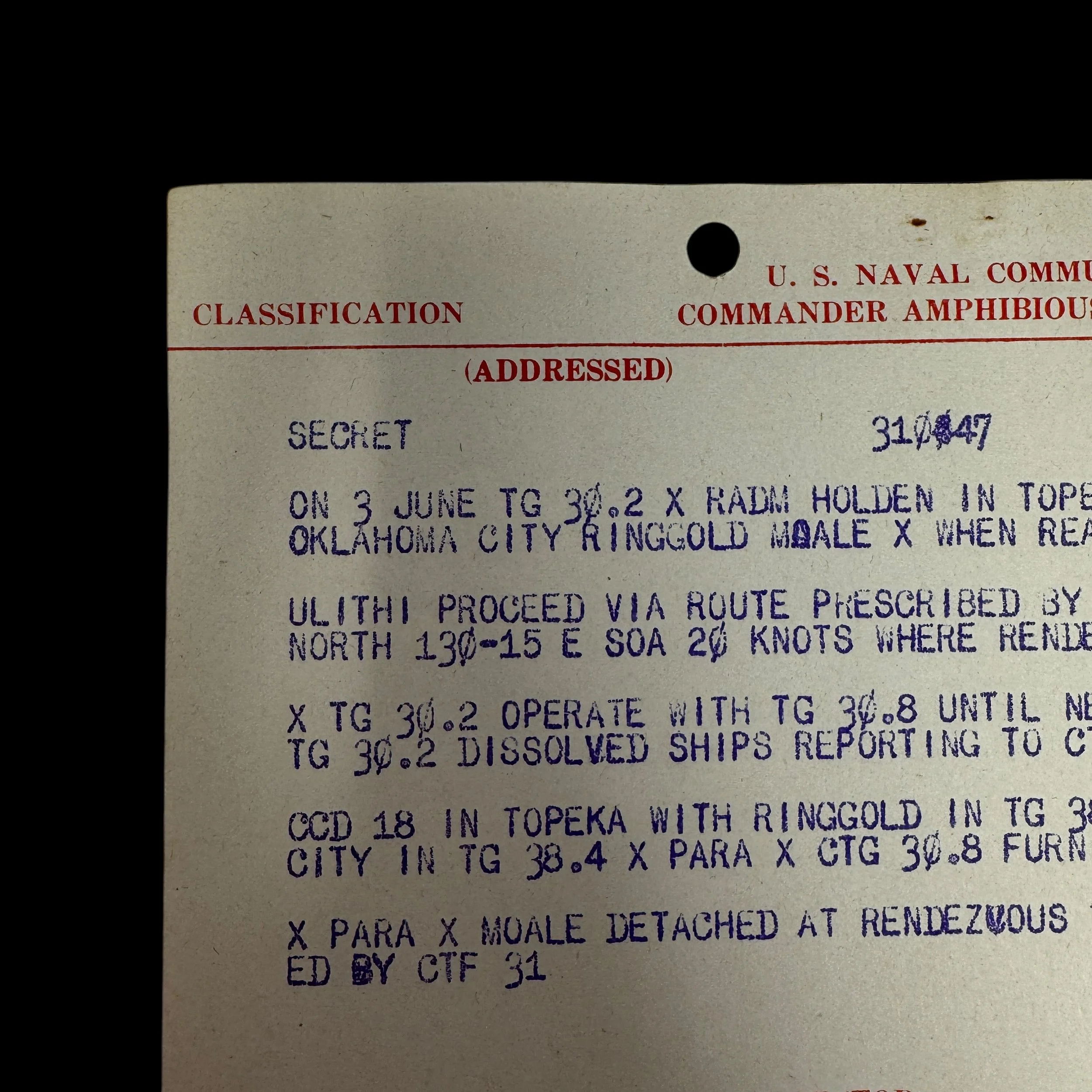
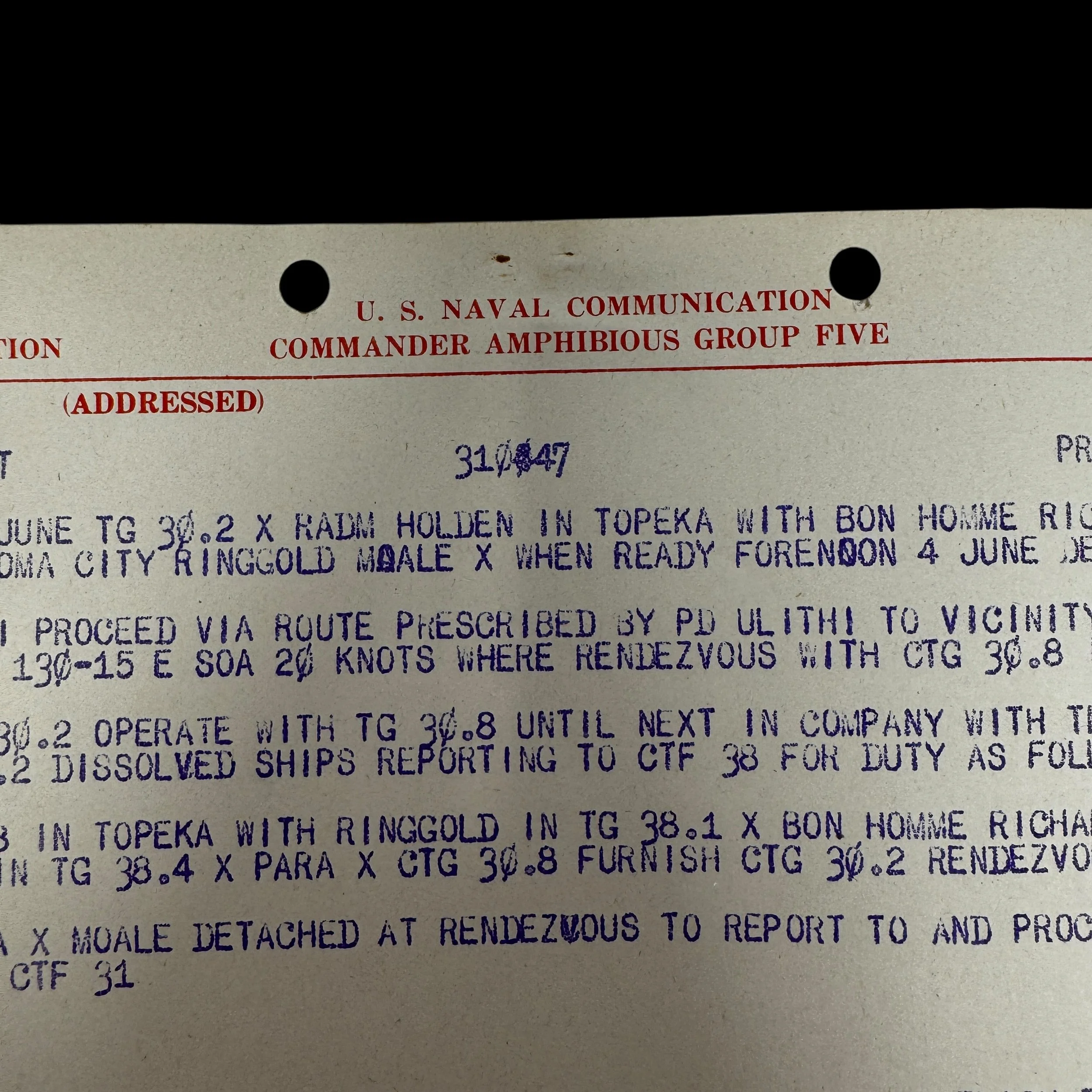


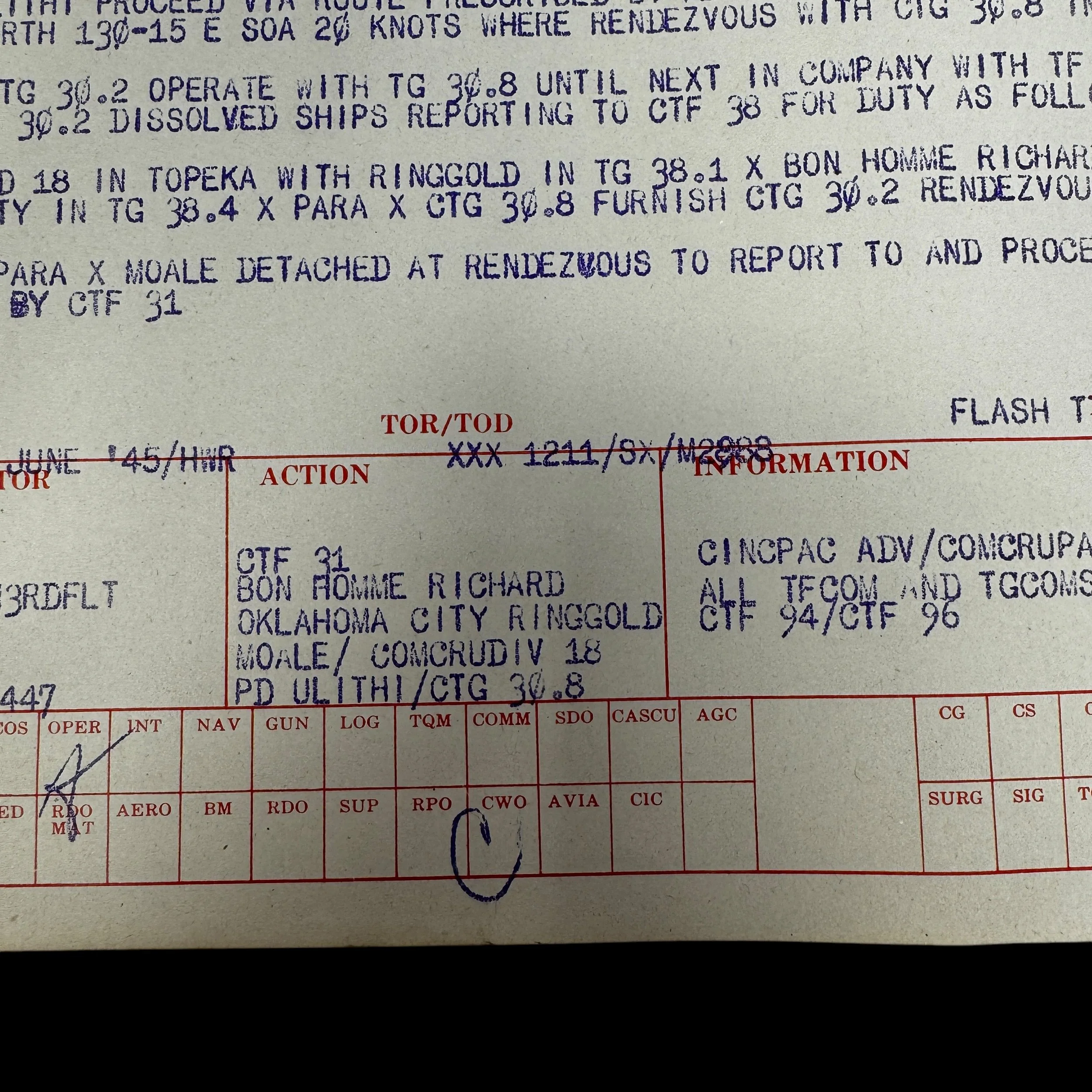


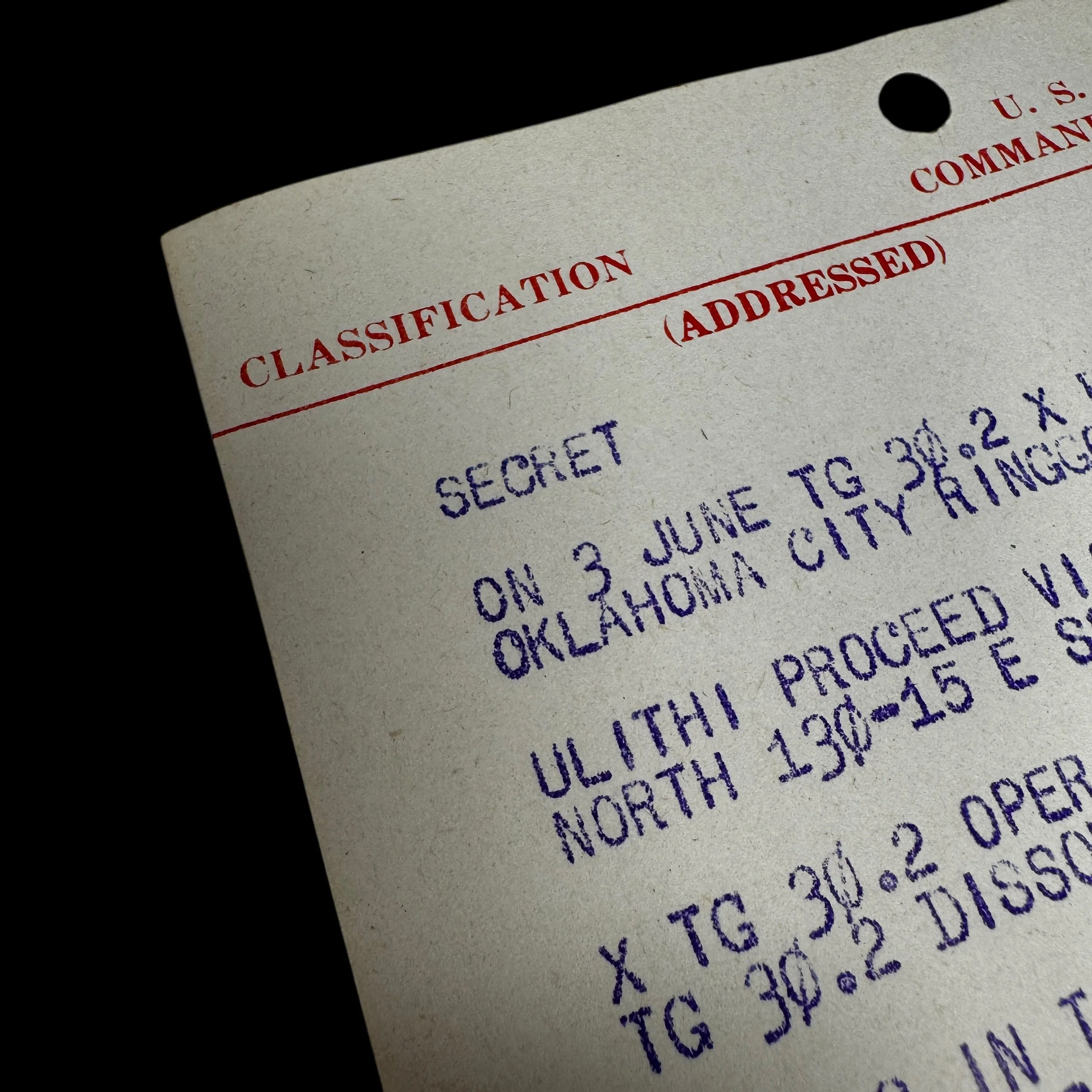
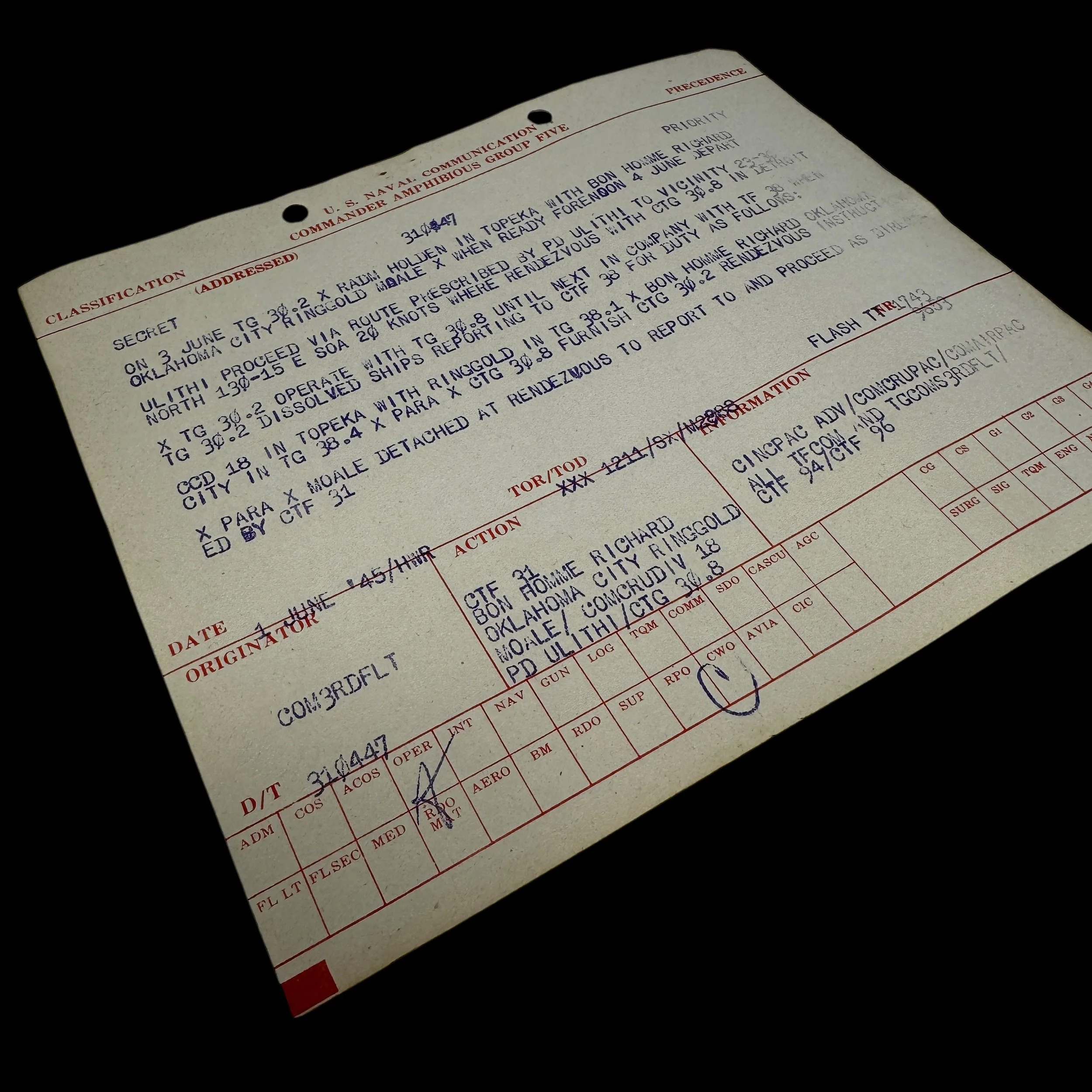
EXTREMELY RARE! WWII "SECRET" June 1st, 1945 USS Bon Homme Richard (CV-31) & USS Oklahoma City (CL-91) Commander of Amphibious Group Five" Admiral Jerauld Wright Combat Intelligence Report (1 Page)
Comes with C.O.A.
This extremely rare and museum-grade WWII artifact is a U.S. Naval Communication combat intelligence report for Rear Admiral Jerauld Wright - Commander of Amphibious Group Five (a newly created unit of the Amphibious Forces, U.S. Pacific Fleet, commanded by Vice Admiral Richmond Kelly Turner). Dated June 1st, 1945 this SECRET U.S. Pacific Theater intelligence report was produced on Rear Admiral Jerauld Wright's flagship USS Ancon (AGC-4). This intelligence report provided Rear Admiral Jerauld Wright - Commander of Amphibious Group Five with intelligence of the Pacific Theater operations such as U.S. Marine advances, POW captures, MIA reports, Japanese strongholds, divisional movements, retreats, resistance pockets, airstrikes reports, etc. Rear Admiral Jerauld Wright was awarded a Bronze Star, with a combat "V" device, for his leadership as the commander of Task Group 51.2 during Operation Iceberg.
Dated June 1st, 1945, this secret World War II Pacific Theater combat report provides an extensive and highly detailed account of the movements, operations, and strategic objectives of the United States Navy Central Task Force in the final months of the Pacific War. This crucial period, spanning from June 1945 to the surrender of Japan on September 2nd, saw intense naval engagements, large-scale carrier-based air raids, and the relentless push toward the Japanese mainland.
The report specifically tracks the deployments and operational directives of key naval vessels within the Central Task Force, including the USS Bon Homme Richard (CV-31), an Essex-class aircraft carrier, and the USS Oklahoma City (CL-91), a Cleveland-class light cruiser. These ships played pivotal roles in the U.S. Navy's sustained pressure against Imperial Japan, engaging in offensive operations that weakened Japan’s ability to wage war.
Strategic Naval Operations in the Central Pacific (June – August 1945)
By June 1945, U.S. forces had effectively secured Okinawa, the last major stepping stone before an anticipated invasion of Japan. The Central Task Force, operating as a key component of the larger U.S. Third Fleet, began shifting its focus toward launching sustained air raids on the Japanese home islands while maintaining naval superiority in the Pacific.
1. Carrier-Based Air Strikes
The USS Bon Homme Richard (CV-31) was an integral part of Task Force 38, the fast carrier strike group of the Third Fleet under Admiral William "Bull" Halsey. This carrier launched multiple aerial assault waves targeting industrial centers, military bases, and strategic infrastructure throughout Honshu, Kyushu, and the Tokyo metropolitan area. Fighter-bombers and torpedo aircraft from the carrier conducted raids against Japanese airfields, naval ports, and shipyards, neutralizing enemy aircraft and preventing kamikaze strikes on American vessels.
2. Naval Gunfire Support and Escort Operations
The USS Oklahoma City (CL-91), as part of the Central Task Force, played a crucial role in naval bombardments against Japanese coastal defenses. The ship provided shore bombardment fire support against heavily fortified enemy positions on Kyushu and the southern islands of Japan, paving the way for potential amphibious operations. The light cruiser also conducted escort and screening duties for the larger carrier task groups, protecting high-value capital ships from Japanese submarine and aircraft threats.
3. Anti-Submarine Warfare and Kamikaze Defense
As Japan intensified its desperate kamikaze (suicide attack) campaign, the Central Task Force was constantly engaged in defensive operations against enemy aircraft. Both the USS Bon Homme Richard and the USS Oklahoma City, along with destroyer escorts, worked to neutralize incoming kamikaze attacks before they could strike American warships. Meanwhile, U.S. destroyers and escort carriers performed anti-submarine patrols to eliminate the dwindling but persistent Japanese submarine threat.
Final Operations Leading to Japan’s Surrender (August – September 1945)
Following the atomic bombings of Hiroshima and Nagasaki on August 6th and 9th, 1945, and the Soviet Union’s entry into the war against Japan, the Central Task Force remained on high alert for any last-ditch resistance from the Imperial Japanese Navy. The USS Bon Homme Richard continued combat air patrols and reconnaissance missions over Japan, monitoring for potential counterattacks. The USS Oklahoma City, alongside other cruisers and destroyers, was involved in the naval blockade of Japan, cutting off maritime supply routes and further isolating the home islands.
With Japan’s official surrender on September 2nd, 1945, aboard the USS Missouri (BB-63) in Tokyo Bay, the Central Task Force was tasked with securing occupied waters, overseeing the demilitarization of Japanese naval forces, and assisting in the repatriation of Allied prisoners of war. Both the USS Bon Homme Richard and USS Oklahoma City were among the many ships that transitioned from combat operations to post-war occupation and security duties in the Pacific.
This classified combat intelligence report provides a rare and invaluable insight into the final naval operations of the U.S. Pacific Fleet. It showcases the relentless efforts of the Central Task Force in ensuring American naval dominance, crippling Japan’s defensive capabilities, and ultimately bringing the war to an end. The USS Bon Homme Richard and USS Oklahoma City, along with the vast naval forces under the command of Admiral Halsey, played a critical role in shaping the outcome of the Pacific War, demonstrating the overwhelming might and strategic efficiency of the United States Navy.
Amphibious Group Five:
In November 1944, Rear Admiral Wright took command of Amphibious Group Five, a newly created unit of the Amphibious Forces, U.S. Pacific Fleet, commanded by Vice Admiral Richmond Kelly Turner. Wright's group would be involved in the invasion of the Ryukyu Islands (Operation Iceberg), the island of Okinawa being the key objective. Once taken, U.S. forces would use Okinawa as a staging area for the eventual invasion of Japan, and a base for the B-29 Superfortress bombers of the U.S. Seventh Air Force to attack the Japanese home islands.[ Amphibious Group Five would transport the 2nd Marine Division, Major General Thomas E. Watson, USMC, commanding, with Wright flying his flag from USS Ancon (AGC-4).
For Operation Iceberg, Wright's force was designated Demonstration Group Charlie (Task Group 51.2), whose mission was to serve as a decoy force working in conjunction with the Southern Attack Force (Task Force 55) commanded by Rear Admiral John L. Hall while the Western Islands Group (Task Group 51.1) under Rear Admiral Ingolf N. Kiland and the 77th Infantry Division secured Kerama Retto and other offshore islands before landing at Ie Shima. Task Group 51.2 would subsequently serve as a floating reserve for the U.S. Tenth Army (Task Force 56), commanded by Lieutenant General Simon B. Buckner, USA, before returning to Saipan.
Wright was ordered to Pearl Harbor to begin planning the invasion of the Japanese home islands, which would begin with Operation Olympic, the invasion of the southern island of Kyūshū. Wright's Amphibious Group Five would be part of the 5th Amphibious Force, commanded by Vice Admiral Harry W. Hill, which would land the V Amphibious Corps (VAC) on the west coast in the Kaminokawa – Kushikino area. Amphibious Group Five would consist of four old battleships, ten cruisers, fourteen destroyers, and seventy-four support craft. However, Operation Olympic and the follow-up invasion of Honshū (Operation Coronet) were cancelled following the dropping of the atomic bombs on Hiroshima and Nagasaki. Rear Admiral Jerauld Wright was awarded a Bronze Star, with a combat "V" device, for his leadership as the commander of Task Group 51.2 during Operation Iceberg.